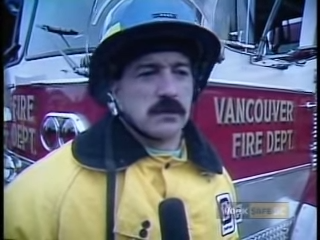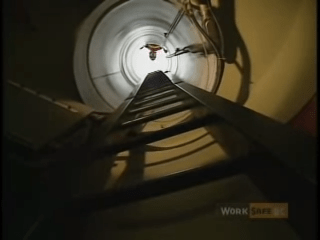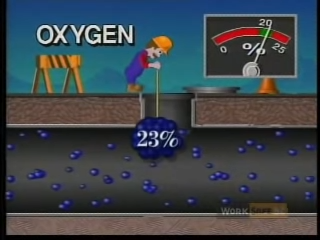Many people find themselves working in confined spaces every day, whether it be in sewer systems, drains, or other tight spots. These areas come with their own unique risks to life and limb that must be carefully considered in order to avoid disaster.
To this end, the Worker’s Compensation Board of British Columbia, known as WorkSafe BC, produced a video on the dangers of working in these areas. Confined Spaces, Deadly Spaces highlights how these areas can kill, and the right way to work around these hazards.
Things Can Change In Seconds
Warning: The last 90 seconds of this video features flashing graphics that may cause photosensitive seizures.

The video starts as so many safety videos do, by showing a variety of workers blithely ignoring the risks of their occupation. They snidely brag about their ability to respond to danger, and claim that taking precautions is too time consuming to bother with. It’s setting us up to realise that these people are dead wrong, and does so by highlighting several cases that illustrate precisely why.
Actual studies of incidents that lead to loss of life in confined spaces are quoted to indicate the very real dangers at play. There are also simulated scenes of confined space accidents, including a fabricated news report with a mustachioed firefighter lamenting that workers didn’t follow proper procedures. It’s all typical safety video fare, well executed and cleanly produced.
As the video shows, the issues around confined space work are manifold. With poor ventilation, and often underground, they can easily become filled with toxic gases. Two of the most common are hydrogen sulfide and carbon monoxide.
Common Dangers for Utility Workers

Hydrogen sulfide may fill a space due to decomposing biological matter, or leech in from chemical spills or other sources like sewers. It’s highly dangerous, and damages the nervous system most prominently. At low levels, hydrogen sulfide has a strong rotten egg smell, and can cause eye damage and fatigue among other symptoms. At higher levels, it can knock out the olfactory nerve, cutting off the sense of smell. At these elevated concentrations, it can cause collapse and death within seconds.
Carbon monoxide acts as an asphyxiant, bonding more readily with haemoglobin in the blood than oxygen. It can lead to death in even low concentrations, and is a colorless, odorless gas. It’s typically found in confined spaces as the result of incomplete combustion of carbon-based fuels, or as a byproduct of operations like welding.

The video also notes that there are a broad spectrum of risks from other gases, but also from oxygen depletion. Oxygen normally makes up 21% of the air around us, but in confined spaces, this number can be much lower. It can be used up by microbial activity, rusting metals, or other chemical processes, that strip much of the oxygen from the air. As levels decrease, workers can quickly suffer the effects of hypoxia, from confusion and delirium all the way up to death.
Highlighting the range of risks to workers in these situations, the video then aims to indicate the proper procedures to mitigate these problems. Relying on rescue in the event of a problem is right out. Often, death occurs quickly, and attempting rescue often puts the rescuers themselves at risk from whatever incapacitated the first worker themselves.
The Safety Gear
Not to worry, the video does turn its focus to mitigation strategies. Portable gas monitors should be used to carefully check the confined space at multiple levels for safe oxygen concentrations and an absence of toxic gases. This is necessary as different gases may collect at different heights in a space due to their relative weight relative to air. Ventilation should also be used to pump fresh air into a space to further ensure safety. And, in the event that rescue is required, a spotter outside the confined space should call for help, and rescuers should use appropriate apparatus to avoid becoming overcome themselves.

It’s all presented in a very matter-of-fact style that’s clear and easy to understand. It’s also paired with what are, for 1994, innovative graphics akin to the 2D platform games popular in the era. Seeing our intrepid underground worker becoming overwhelmed with green blobs of hydrogen sulfide drives home how quickly things can get out of hand in confined spaces. It’s all wrapped up with a few main dot-points at the end of the video, delivered with flashing graphics clearly designed to wake up bored workers dozing off in a mandatory training session. However, it’s somewhat of a poor choice, as the rapid flashes could cause photosensitive seizures in some viewers.
Overall, despite its age, it’s a great primer on the basic dangers and necessary precautions around working in confined spaces. It’s no substitute for appropriate worksite-specific training, but serves as a good primer for those unfamiliar with the practices involved.
















“Working in a confined space”: Get Covid-19.
Surprisingly, if properly ventilated, confined space work may be safer than the office.
The office when ocupied sits at about 1500ppm CO2, with ventilation, which is considered good.
One of the jobs I was on last month (repair between a double hull of a commerial ship- VERY tight, a–hole to elbow tight, confined space, limited access) we had roughly 15 workers in the space (it varied over the 30 hour job). Continuous monitoring was required, and none of the personal monitor CO2 sensors rose much above the 450ppm level of the vent air. This indicates sufficient dilution that COVID was not s significant worry.
The primary concerns were O2 level and SO2 (normally closed/unvented space in a steel vessel), as well as combustible vapor and welding fume. Couldn’t even smell the guys that were smoking (technically not legal, but come on…. we’re welding in there.)
I worry much more about COVID at the grocer. WAY too many “freedom fighters” for my comfort.
Amazing what ventilation can do. My eyes have been opened since I bought an SCD30 CO2 sensor breakout from Adafruit. My home has stupidly high indoor levels (yes the sensor is calibrated) that at best get down to 1000 ppm on their own. Suffice it to say, we’re gonna have an ERV (energy recovery ventilator: basically fresh air fan plus heat exchanger) installed here once the COVID-19 numbers go back down enough that we feel comfortable having someone in. I imagine it will be worst these next few months when it’s temperate enough outside that the HVAC won’t have to run much. Even with it on “circulate mode” (force fans on low 1/3 the time) I’ve got enough graphs here that show me that when AC isn’t running, CO2 just keeps climbing.
Get some houseplants. The hvac changes are good as well.
Het a houseplant. They love CO2.
I would not really call this retrotacular this happened nearby recently.
https://fortwaynesnbc.com/2020/08/27/sewer-project-in-columbia-city-claim-three-lives-tuesday/
I know of a case from ten years ago when six people died in a septic tank. One person lost consciousness while cleaning the tank and the others, family and neighbors, went in one by one to rescue… all died.
The flashing images definetly imprinted something in my brain
I appreciate the irony of a safety instruction video using rapidly flashing lights without warning.
Allover Indiana and elsewhere combined storm and sanitary sewers are being separated tearing up intersections. When it rains hard the river won’t become a temporary toilet. In our town an old baseball park was demolished and a huge pit placed under the field a new diamond was built on it and the stands moved around so fly balls don’t error with traffic.Another park’s diamond had also been dug up, the contractor muffed up and had to re-pour and now another sewer backup exists. Huge chambers underground and potentially dangerous gasses too.
I would love to hear the reverb in one of those tanks, via a speaker and binaural pickup.
Yeah. My dad used to work in wastewater treatment, so if he had to go inspect a sewer or something I remember he had an SCBA – literally scuba without the “underwater” – self contained breathing apparatus. I get it can be cumbersome, and not all companies take safety seriously, but jeepers, you’d hope we’d have stopped the H2S deaths by now.
I remember a youtube video from a guy who bought an old underground bunker of some kind and was aiming to pump it out / refurbish it.
In one video, him and others gain access and start exploring. At one point, their voices start to sound like they’re on helium. One of them realizes what’s going on and they bail. Not sure what the gas was, but clearly it was not proper breathing air and they had no idea they walked right into it. He prefaces the video by saying they were incredibly stupid to not be testing the air and to not have anyone on watch, and lucky to be alive.
Hey I remember seeing that too. From the channel Death Wears Bunny Slippers:
https://www.youtube.com/watch?v=CXpYFtI0nqU&t=0s
At work, they have an “immersion well” for testing water flow and depth instruments. It’s in a corner of the counter in the lab, like a “lazy susan” with a lid on top. There’s a sign that says, “Confined space! DO NOT ENTER!!!” over it that always makes me shudder. It’s about 10 feet deep, about 2 feet in diameter, and full of very cold water. Just the thought of going in there head first trying to reach something that sank and getting stuck, unable to turn around or stand up, gives me nightmares…
this is why you learn to pick up things with your toes. :-D
I had a confined space training recently and one of the interesting things was the variety of space that can be considered “confined” – there’s also entrapment to worry about. In particular, I remember them talking about trenches counting as a confined space if they’re above chest-deep with no easy egress. In an emergency, it can be much harder than you might think to exit a space. The instructor had investigated a collapse of just such a trench with a fatality. Your head can be in the open air, but if dirt covers your chest, you might not be able to breath…
A good reminder that every safety rule lies on top of a dead body, usually of someone that “knew better” or had “done it a thousand times”. Safety is often the most annoying hat I wear, but when everyone goes home ok, a satisfying one.
Or as AvE often says, “those safety rules are written in blood”
Good video. One thing it doesn’t mention is nitrogen, which is used in industrial situations. You can see one such nitrogen asphyxiation accident documented in a CSB report (US Chemical Safety Board) here: https://www.youtube.com/watch?v=tltN0wTZ0ck (6:44 duration)
Sorry, the above link was for an edited version of the original video. The official version is here: https://www.youtube.com/watch?v=f2ItJe2Incs (12:06 duration)
These official accident investigation videos are quite a popular, if somewhat morbid, genre on YouTube. I’ve seen a few, what I like the best is how there’s always more than one problem identified (swiss cheese model) in such a thorough inquest. Recently just saw one from us csb on an H2S poisoning at a petroleum facility of some sort. Pager goes off, on call guy goes to investigate without proper procedures or equipment, killed very quickly when he enters the wrong place at the wrong time, his wife can’t reach him on the phone so she goes to check on him (no access control), she dies also, orphaned two kids. Terrible tragedy. You’d think we’d know better and do better, but the company in this case had a lot of blame for unsafe practices. I’m sure much of it comes down to the almighty dollar.
No one ever dies from a money overdose.
I’d volunteer to find the LD50.
Elvis
Michael Jackson
I’ll add to what else has been said here, EVERYONE should take a look at Paul O’Neill, the former CEO of Alcoa, and, prior to that, Int’l Paper. He followed up with a post in the Bush admin (Bush 2).
He really, seriously, focused on safety, and damn near got canned from Alcoa before he started, since no one believed it it was a financially sound concept.
He increased the value of the company by roughly 900% in 10 years (3B$US to 27B$US), while greatly reducing the number of incidents.
See: https://vimeo.com/203872993 if you have an hour. (the same video is avail elsewhere, as well. This just happens to be the link I have bookmarked)
Ventis MX-4…. They have saved me a few times.
this is apart of getting a “white card” here in SA, you can’t go on a jobsite without one
they showed us a few scary videos with storm drains, but I knew of a bloke that died in the under floor space
one minute he was talking, the next gone
At Secunda you sometimes see workers with plastic buckets on a rope scooping a manhole before entering. To the untrained eye they look crazy, scooping out non existing water, when in reality it’s removing possible heavier than air gasses. To ignore safety precautions because you have been OK so far, is like letting your kid play in the road because they have not been run over so far. It’s just a matter of time.
A lot of people have died in holes in the ground – I’ve had the safety training and also (often more memorable) the stories from engineers & instructors about folks who either messed up or whose death uncovered some previously unknown or under-rated danger.
No mention of why Oompa-Loompas were used in the video?